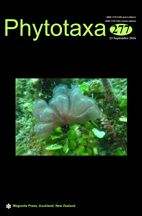Abstract
A new species of Chrysosplenium (Saxifragaceae), C. zhangjiajieense, is described and illustrated from Zhangjiajie, Hunan province in China. This new species is similar to C. macrophyllum in having broad basal leaves and compact cymes, but it differs from the latter in that the whole plant of C. zhangjiajieense is densely covered by coarse and long white villus, and the leaf adaxial surface bears thickly wart points. The new species is also similar to C. davidianum, but differs by having white flowers, only one cauline leaf, oblong sepals and the stamen is longer than sepals while C. davidianum possess yellow flower, 2–5 cauline leaves, orbicular sepals and the stamen much shorter than sepals. Base on the field investigation, this new species is accessed to be endangered according to IUCN category and criteria.

